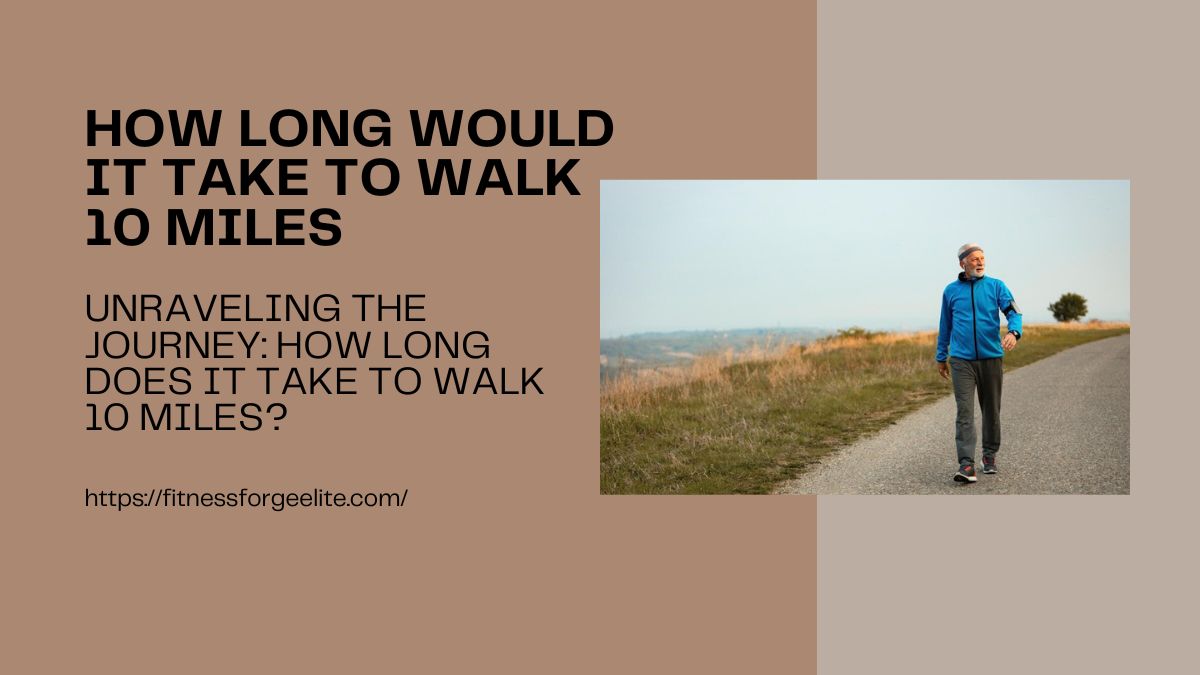Walking is not just a mode of transportation; it’s an experience—a journey that can lead to internal and external discoveries. Have you ever wondered how long it would take to walk a specific distance, say 10 miles? In this comprehensive guide, we’ll delve into the intricacies of walking pace, the factors influencing it, and how to accurately estimate the time it takes to cover 10 miles on foot.
Understanding Walking Pace
Walking pace is the rate at which an individual moves while walking, typically measured in distance covered per unit of time. It’s influenced by various factors, each contributing to the overall speed of the walker.
Factors Influencing Walking Pace
Terrain and elevation
Terrain and elevation play a significant role in determining walking pace. Walking on flat even surfaces like pavement allows for a faster pace compared to walking on rugged terrain with steep inclines. Uphill climbs require more effort and consequently slow down the pace, while downhill stretches may increase speed but require caution to avoid injury.
Read More: How Many Minutes Does it Take to Travel 30 Miles?
Fitness level and physical condition
Fitness level and physical condition also affect walking pace. Individuals with higher fitness levels and better cardiovascular health tend to walk faster and sustain their pace for longer durations. Conversely, those with lower fitness levels may need to take more frequent breaks or walk at a slower pace.
Weather conditions
Weather conditions such as temperature, humidity, and wind can impact walking pace. Extreme heat or cold may slow down the pace as the body works harder to regulate temperature, while strong winds can create resistance, making it more challenging to maintain speed.
Calculating Walking Time for 10 Miles
Now that we understand the factors influencing walking pace, let’s calculate the time it would take to walk 10 miles, considering these variables.
Basic Calculation: Average Walking Speed
The average walking speed for adults is approximately 3 to 4 miles per hour. Using this as a baseline, we can estimate that walking 10 miles at an average speed would take roughly 2.5 to 3.5 hours. However, it’s essential to adjust this estimate based on the specific circumstances of the walk.

Adjusting for Terrain and Elevation Changes
If the route includes significant changes in terrain or elevation, the walking pace will vary accordingly. To account for this, it’s helpful to break down the route into segments and adjust the estimated time for each based on the expected difficulty level.
For example, walking uphill will naturally slow down the pace, so it may take longer to cover a mile than walking on flat ground. Conversely, walking downhill may allow for a faster pace, but caution must be exercised to avoid injury.
Considering Fitness Level and Physical Condition
Individual fitness level and physical condition play a crucial role in determining walking pace. While some may be able to maintain a brisk pace for an extended period, others may need to take more frequent breaks or walk at a slower speed.
To calculate walking time accurately, it’s essential to assess your fitness level honestly and adjust the estimated time accordingly. If you’re unsure, it’s always better to err on the side of caution and allow for more time than you think you’ll need.
Weather Considerations and Their Impact
Weather conditions can significantly affect walking pace. Extreme heat, cold, wind, or precipitation can all slow down the pace and make walking more challenging.
Before setting out on a walk, check the weather forecast and plan accordingly. If conditions are less than ideal, consider adjusting your pace and allowing for extra time to reach your destination safely.
Real-World Scenarios
Walking 10 miles can take on different dimensions depending on the setting—whether it’s urban, rural, or natural landscapes. Let’s explore how walking time varies in these scenarios.
Walking 10 Miles in Urban Areas
In urban environments, walking 10 miles can be a practical mode of transportation or a leisurely way to explore the city’s sights and sounds. However, navigating crowded streets, traffic signals, and intersections can slow down the pace compared to walking in more open spaces.
Typically, in urban areas with sidewalks and pedestrian-friendly infrastructure, walking 10 miles at a moderate pace may take around 2.5 to 3.5 hours. However, this estimate can vary depending on foot traffic, street crossings, and obstacles along the route.
To expedite your journey in urban settings, consider choosing routes with fewer obstacles and less foot traffic, such as dedicated pedestrian paths or parks. Additionally, wearing comfortable shoes and staying hydrated can help maintain your pace and endurance throughout the walk.
Walking 10 Miles in Rural or Natural Settings
Walking in rural or natural settings offers a different experience, with scenic landscapes, tranquil surroundings, and varied terrain to navigate. While the absence of urban congestion may allow for a faster pace, factors such as uneven terrain, trail conditions, and elevation changes can present their challenges.
In rural or natural settings, walk 10 miles may take slightly less time compared to urban areas, depending on the difficulty of the terrain. On well-maintained trails with gentle slopes, it’s possible to cover the distance in 2.5 to 3.5 hours, similar to urban environments.
However, if the route includes rugged terrain, steep inclines, or challenging trail conditions, it may take longer to complete the journey. In such cases, it’s essential to pace yourself accordingly, take breaks as needed, and stay mindful of your surroundings to ensure a safe and enjoyable walk.
Enjoying the Journey: Benefits of Walking in Nature
Walking in natural settings offers numerous benefits beyond physical exercise. It provides an opportunity to connect with nature, reduce stress, and improve overall well-being. Whether it’s a stroll through a park or a challenging hike in the mountains, spending time outdoors can rejuvenate the mind, body, and spirit.
To maximize the benefits of walking in nature, take time to appreciate the beauty of your surroundings, listen to the sounds of the environment, and immerse yourself in the present moment. Whether you’re walking alone or with company, use the opportunity to reflect, recharge, and reconnect with yourself and the world around you.
Personalized Estimations
While general guidelines can provide a starting point for estimating walking time, it’s essential to personalize your calculations based on your circumstances and preferences.
Tailoring Walking Time Calculations to Individual Circumstances
Factors such as fitness level, walking speed, terrain familiarity, and personal preferences all play a role in determining how long it will take to walk a specific distance. By taking these factors into account, you can create a more accurate estimate of your walking time and plan your journey accordingly.

To tailor your walking time calculations to your circumstances, consider the following:
- Fitness Assessment and Goal Setting: Assess your current fitness level and set realistic goals based on your abilities and objectives. If you’re new to walking or have limited experience, start with shorter distances and gradually increase the distance as your fitness improves.
- Customizing Walking Routes: Choose routes that align with your preferences and abilities. If you prefer flat, paved surfaces, opt for urban pathways or park trails. If you enjoy more challenging terrain, explore hiking trails or natural landscapes that offer varied terrain and elevation changes.
- Adjusting Expectations: Be flexible and adjust your expectations based on the specific circumstances of each walk. Factors such as weather conditions, terrain difficulty, and personal fatigue can all affect your walking pace and overall experience. Listen to your body, take breaks as needed, and enjoy the journey at your own pace.
By personalizing your walking time calculations and adjusting your expectations accordingly, you can ensure a more enjoyable and fulfilling walking experience.
Tools and Resources for Precise Estimations
Several tools and resources are available to help you calculate walking time more precisely and plan your walking routes effectively. These include:
- Online Walking Route Planners: Websites and apps such as Google Maps, MapMyWalk, and AllTrails allow you to map out walking routes, calculate distances, and estimate walking times based on your chosen pace.
- Fitness Trackers: Wearable fitness trackers and smartphone apps with built-in GPS capabilities can track your walking distance, speed, and time, providing real-time feedback on your progress and performance.
- Walking Time Calculators: Various online tools and calculators are available to estimate walking time based on factors such as distance, pace, terrain, and elevation. These calculators can help you plan your walks more effectively and set realistic goals for your fitness journey.
By leveraging these tools and resources, you can enhance your walking experience, stay motivated, and achieve your fitness goals more effectively.
Tips for Enhancing Walking Pace and Efficiency
While walking is a simple and accessible form of exercise, there are several tips and strategies you can use to enhance your walking pace and efficiency.
Training Techniques to Improve Walking Speed
- Interval Training: Incorporate intervals of high-intensity walking or jogging into your routine to improve cardiovascular fitness and speed.
- Strength Training: Include strength exercises such as squats, lunges, and calf raises to build lower body strength and improve walking efficiency.
- Proper Form: Pay attention to your posture, stride length, and arm swing to optimize walking mechanics and increase speed.
Equipment Considerations for Comfort and Efficiency
- Footwear: Choose supportive, comfortable shoes with good cushioning and proper arch support to reduce fatigue and minimize the risk of injury.
- Clothing: Wear moisture-wicking, breathable fabrics to stay cool and dry during walks, and layer clothing to adjust to changing weather conditions.
- Hydration and Nutrition: Stay hydrated before, during, and after walks, and fuel your body with nutritious foods to maintain energy levels and endurance.
Mental Strategies for Maintaining Motivation and Focus
- Set Goals: Establish short-term and long-term goals for your walking journey, such as increasing distance, improving speed, or exploring new routes.
- Mindfulness: Practice mindfulness techniques such as deep breathing, visualization, and positive self-talk to stay focused and present during walks.
- Variety: Keep your walks interesting and engaging by exploring different routes, environments, and walking companions.
By incorporating these tips and strategies into your walking routine, you can enhance your pace, efficiency, and overall enjoyment of walking as a form of exercise and recreation.
Conclusion
Walking is more than just a means of getting from point A to point B; it’s an opportunity to explore, discover, and connect with the world around us. By understanding the factors influencing walking pace and accurately estimating walking time, we can embark on walking journeys with confidence, preparedness, and a sense of adventure.
Whether you’re navigating urban streets, wandering through natural landscapes, or simply enjoying a stroll in your neighborhood, embrace the journey, appreciate the moments, and savor the experience of putting one foot in front of the other.
Frequently Asked Questions
At an average walking speed of 3 to 4 miles per hour, it would take approximately 2.5 to 3.5 hours to walk 10 miles.
Walk 10 miles, Terrain and elevation changes, fitness level and physical condition, weather conditions, surface type, and personal preferences all influence walking pace and time estimation.
Incorporate interval training, strength exercises, and proper form techniques into your routine, choose supportive footwear and breathable clothing, stay hydrated and fueled, set goals, practice mindfulness, and vary your walking routes and environments.

